International Journal of Image, Graphics and Signal Processing @ijigsp
Статьи журнала - International Journal of Image, Graphics and Signal Processing
Все статьи: 1157

An Object of Interest based Segmentation Approach for Selective Compression of Video Frames
Статья научная
The automatic segmentation of objects of interest is a new research area with applications in various fields. In this paper, the object segmentation method is used for content based video management and compression of video frames for video conferencing. The face region, which is the object of interest in the video frames, is identified first using a skin color based algorithm. The face regions are then extracted and encoded without loss, while the non- face regions and the non-face frames are quantized before encoding. Results show that the decompressed video has an improved quality with the proposed approach at low bit rates.
Бесплатно
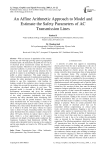
An affine arithmetic approach to model and estimate the safety parameters of AC transmission lines
Статья научная
With an increase in population of the country day by day and with high growing speed of geographical residential plots, the demand by the public for new set up of electrical power transmission system has become a common mandate. Therefore it is the responsibility of the concerned authority to protect the interests of common man in a smart manner and develop solutions for the growth of country in an intelligent way keeping safety of public as prime importance. This paper proposes an Affine Arithmetic approach of mathematical modelling to estimate the safety parameters of AC transmission line leading to sag, like, temperature, wind loading, ice loading, weight of the conductor, stress, tension, pressure etc., taking into account the uncertainty conditions so that the solutions developed address in real time. The proposed model is executed in MATLAB integrated development environment and gives the complete behavior of sag in transmission lines with respect to each of the safety parameters individually and closely ascertains the safety threshold limits considering 50% factor of safety and 5m ground clearance. The critical safety threshold limit for wind loading is found to be about 3.02 kg/m and the typical value is about 1.51 kg/m. Similarly, the critical safety threshold limit for weight of ice is found to be about 1.45 kg/m, whereas its typical value is about 0.7 kg/m. Extending further, the critical safety threshold limit for conductor weight is found to be about 3.07 kg/m, whereas its typical value is about 1.6 kg/m, which is a close approximation to the typical weight per unit length of industry-grade conductors like Aluminum Conductor Steel Reinforced (ACSR). The critical safety threshold limit for tension in the conductor and the span lengths are found to be 1850 kg and 230m respectively.
Бесплатно
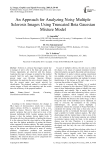
Статья научная
Sclerosis is a disease that triggers mainly due to damage of nerve cells in the brain and spinal cord. Various impairments are observed with this disease. Analyzing this type of images is needed for the medical research field for early stage identification. So, the present paper uses Bivariate Gaussian Mixture distribution for analyzing the noisy sclerosis images. For this, the present paper uses neural network for classification. The proposed method is evaluated with various images of brain web repository and the results show the efficiency of the proposed method.
Бесплатно
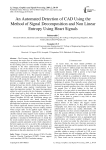
Статья научная
The Coronary Artery Disease (CAD) which is one among the major class of cardiovascular diseases is emerging as an epidemic in the society and has proven to be the leading cause for more number of deaths when compared to the other cardiovascular diseases. It is emerging as one of the threats to the economy. It has become very important to detect CAD in its early stage which can help society in a broader way by saving a significant number of lives. The proposed method is a novel efficient automated approach which is capable of detecting CAD among the large group of patients using Electrocardiogram (ECG) signal. The system design provides a complete model of pre-processing of ECG, finding the heart rate which is further decomposed up to 4 level sub-bands using analytic transformation based signal decomposition method. The signal decomposition method is used to analyze the low frequency components of the signal and to deal with non stationary nature of heart signals. Two Non-linear entropy estimators as K-Nearest Neighbor (K-NN) and Correlation entropy are applied to decomposed sub- bands obtained after applying Analytic wavelet transformation based flexible decomposition technique to extract non-linear dynamics. The clinical significant features from the large data set can be selected by employing wilcoxon ranking method which assigns ranks on the applied signal. Further, an entropy-based classification approach and a suitable classifier namely Linear support vector machine (L-SVM) is used to classify among CAD and normal class. The algorithm is simulated in MATLAB and it is found that the results matched closely with the available data. This computer-assisted automated system which characterizes the heart signal can serve as an aid for the cardiologists in their daily screening of a large number of patients and can be used in primary health care centers which help the physicians in the early detection of a CAD.
Бесплатно
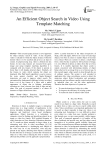
An efficient object search in video using template matching
Статья научная
This research paper presents a novel approach for object instance search in video. At the inception, video is selected for which the object instance within the desired video is to be searched and given as an input to system. In preprocessing step, video is divided into key frames. In next step, features are extracted from query image and using template matching algorithm it is compared with key frames. If the object is present in frame then it will display detected object. Similarly, all the frames in video which contains the object are displayed. Max Path Search algorithm is used to remove the noise against classifier and Spatio-Temporal trajectories are used to improve object search. We encountered the fundamental challenge to detect an object from a set of key frames of a video with a partial appearance of object due to lighting, positioning, occlusion etc. from a known class such as logo and any other. The goal of proposed method is to detect all instances of object from known class.
Бесплатно
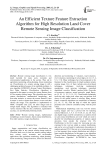
Статья научная
Remote sensing image classification is very much essential for many socio, economic and environmental applications in the society. They aid in agriculture monitoring, urban planning, forest monitoring, etc. Classification of a remote sensing image is still a challenging problem because of its multifold problems. A new algorithm LCDFOSCA (Linear Contact Distribution First Order Statistics Classification Algorithm) is proposed in this paper to extract the texture features from a Color remote sensing image. This algorithm uses linear contact distributions, mathematical morphology, and first-order statistics to extract the texture features. Later k-means is used to cluster these feature vectors and then classify the image. This algorithm is implemented on NRSC ‘Tirupathi’ area 2.5m, 1m color images and on Google Earth images. The algorithm is evaluated with various measures like the dice coefficient, segmentation accuracy, etc and obtained promising results.
Бесплатно
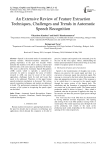
Статья научная
Speech is the natural mode of communication between humans. Human-to-machine interaction is gaining importance in the past few decades which demands the machine to be able to analyze, respond and perform tasks at the same speed as performed by human. This task is achieved by Automatic Speech Recognition (ASR) system which is typically a speech-to-text converter. In order to recognize the areas of further research in ASR, one must be aware of the current approaches, challenges faced by each and issues that needs to be addressed. Therefore, in this paper human speech production mechanism is discussed. The various speech recognition techniques and models are addressed in detail. The performance parameters that measure the accuracy of the system in recognizing the speech signal are described.
Бесплатно
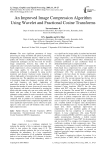
An improved image compression algorithm using wavelet and fractional cosine transforms
Статья научная
The most significant parameters of image processing are image resolution and speed of processing. Compressing the multimedia datasets, which are rich in quality and volume is challenging. Wavelet based image compression techniques are the best tools for lossless image compression, however, they suffer by low compression ratio. Conversely fractional cosine transform based compression is a lossy compression technique with less image quality. In this paper, an improved compression technique is proposed by using wavelet transform and discrete fractional cosine transform to achieve high quality of reconstruction of an image at high compression rate. The algorithm uses wavelet transform to decompose image into frequency spectrum with low and high frequency sub bands. Application of quantization process for both sub bands at two levels increases the number of zeroes, however rich zeroes from high frequency sub bands are eliminated by creating the blocks and then storing only non-zero values and kill all blocks with zero values to form reduced array. The arithmetic coding method is used to encode the sub bands. The Experimental results of proposed method are compared with its primitive two dimensional fractional cosine and fractional Fourier compression algorithms and some significant improvements can be observed in peak signal to noise ratio and self-similarity index mode at high compression ratio.
Бесплатно
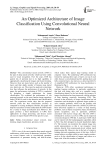
An optimized architecture of image classification using convolutional neural network
Статья научная
The convolutional neural network (CNN) is the type of deep neural networks which has been widely used in visual recognition. Over the years, CNN has gained lots of attention due to its high capability to appropriately classifying the images and feature learning. However, there are many factors such as the number of layers and their depth, number of features map, kernel size, batch size, etc. They must be analyzed to determine how they influence the performance of network. In this paper, the performance evaluation of CNN is conducted by designing a simple architecture for image classification. We evaluated the performance of our proposed network on the most famous image repository name CIFAR-10 used for the detection and classification task. The experiment results show that the proposed network yields the best classification accuracy as compared to existing techniques. Besides, this paper will help the researchers to better understand the CNN models for a variety of image classification task. Moreover, this paper provides a brief introduction to CNN, their applications in image processing, and discuss recent advances in region-based CNN for the past few years.
Бесплатно
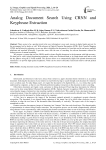
Analog Document Search Using CRNN and Keyphrase Extraction
Статья научная
There seems to be a peculiar trend in the way information is now used, moving to digital media not just for the newspapers but for books as well. With advances in Optical Character Recognition (OCR), Style Transfer Mapping (STM), and efficient key phrasing, we are now able to digitalize the document to a form that can be read across multiple platforms and searched efficiently. It provides users with the ease of searching for relevant documents without the tedious process of manual searching. We propose a system that uses the CRNN model to detect English characters in the document with high accuracy. We then pair it with a hybrid keyphrasing technique, which uses Positional Rank as its Graph based rank and re-rank the key phrases using the C-Value method. This process allows us to automatically digitize the printed document and summarise it to provide high-quality keyphrases, which can be used to efficiently search and retrieve relevant printed documents.
Бесплатно
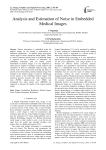
Analysis and Estimation of Noise in Embedded Medical Images
Статья научная
Patient information is embedded inside the medical images for the storage or transmission, or healthcare applications. In medical image processing, various types of noises corrupt the image quality. There is a need of measure specific noise for a particular image is required for the evaluation of robustness for embedding techniques used for hiding patient information in medical images. It is very important to obtain precise images to facilitate accurate analysis and estimation of noise in embedded medical image. The current work is focused towards studying the effect of specific noise which affect particular medical image. The strength of the medical image is tested by introducing several attacks to the embedded medical images. The statistical quantity measures like peak signal-to-noise ratio (PSNR), signal-to-noise ratio (SNR) and normalized root mean square error (NRMSE) are employed to measure the quality of the output medical image.
Бесплатно
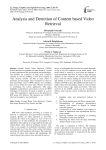
Analysis and detection of content based video retrieval
Статья научная
Content Based Video Retrieval (CBVR) System has been investigated over past decade it’s rooted in many applications like developments and technologies. The demand for extraction of high level semantics contents as well as handling of low level contents in video retrieval systems are still in need. Hence it motivates and encourages many researchers to discover their knowledge across CBVR domain and contribute their work to make the system more effective and useful in developing the system application. This paper highlights comprehensive and extensive review of CBVR techniques for detection of region of interest in a given video. The experiment is carried out for the detection of ROI using ACF detector. The detection rate of ROI is observed competitive and satisfactory.
Бесплатно
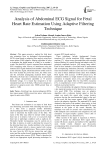
Analysis of Abdominal ECG Signal for Fetal Heart Rate Estimation Using Adaptive Filtering Technique
Статья научная
This paper presents a method for fetal heart rate estimation from an abdominal electrocardiogram (ECG) signal based on adaptive filter analysis using least mean square (LMS) adaptive filtering algorithm in order to determine the health status of a baby in its mother's womb. The fetal ECG signal is extracted from abdominal ECG containing other sources of interference using the maternal ECG signal obtained from mother's chest cavity as the reference signal. Interference/noise model used for this work include the power-line noise, the white noise and the unwanted propagating maternal ECG signal. Thereafter, the heart rate is estimated using an automated peak voltage measurement algorithm at 75 percent threshold voltage. It is found that irrespective of the estimated heart rate of the baby, 100 percent estimation is achieved at signal-to-noise ratio (SNR) greater than or equal to -31dB.
Бесплатно
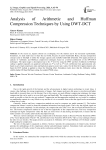
Analysis of Arithmetic and Huffman Compression Techniques by Using DWT-DCT
Статья научная
In the recent era, digital contents are exchanging over the internet and it has increased exponentially. Sometimes, we need small sizes to share the real world, because of narrow bandwidth. Hence, the data compression concept came in limelight to utilize the storage capacity and available bandwidth efficiently. This paper presents an analysis of Arithmetic and Huffman compression techniques based on a hybrid combination of the DWT-DCT techniques. The input image is decomposed up to the 3rd level by using the DWT and then Arithmetic & Huffman coding is applied separately on quantized sub-bands on 2nd as well as 3rd level coefficients from approximation sub-bands to get a high compression ratio and high peak signal-to-noise ratio values. On the third level approximation sub-band, the DCT method is applied to reduce the blocking effect. Simulation results show that the Arithmetic coding exhibits higher CR than Huffman coding, but smaller PSNR values.
Бесплатно
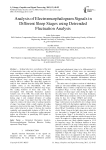
Статья научная
Scaling behavior is an indicator of the lack of characteristic time scale, and the existence of long-range correlations related to physiological constancy preservation. To investigate the fluctuations of the sleep electroencephalogram (EEG) over various time scales during different sleep stages detrended fluctuation analysis (DFA) is studied. The sleep EEG signals for analysis were obtained from the Sleep-EDF Database available online at the PhysioBank. The DFA computations were performed in different sleep stages. The scaling behavior of these time series was investigated with detrended fluctuation analysis (window size: 50 to 500). The results show that the mean values of scaling exponents were lower in subjects during stage 4 and standard deviation of scaling exponents of stage 4 was larger than that of the other stages. In contrast, the mean value of scaling exponents of stage 2 was larger, while a small variation of scaling exponent is observed at this stage. Therefore, DFA has a more stable behavior in stage 2, whereas the random variability and unpredictable behavior of DFA can be observed in the stage 4. In conclusion, scaling exponent indices are efficacious in quantifying EEG signals in different sleep stages.
Бесплатно
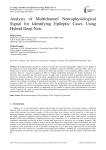
Статья научная
Neurophysiological parameters revealed by resting-state electroencephalography (rsEEG) may be helpful in the diagnosis of various brain diseases like Epilepsy, Alzheimer’s, depressive disorders, and many others. Due to the abrupt onset of seizures, Epilepsy is a chronic nerve illness that interferes with an epileptic patient's regular everyday activities. However, manual investigation of EEG for finding epileptiform discharges by skilled neurologists is a laborious, time-consuming, and error-prone process. It might cause a significant delay in providing clinical care to a person who could have epilepsy. This work offers a straightforward method for analyzing EEG data for the purpose of identifying epileptic features by iteratively simulating multiple deep learning models. It also attempts to include big data analytics for handling the challenge of analyzing the mountain of unstructured EEG data, available and accessible in numerous formats. In contrast to the state-of-the-art works, the performance scores of the proposed methods show significant improvement for the considered assessment parameters. Additionally, after testifying the performance of this proposed technique for relevant datasets, its application can be extended to identify other neurodegenerative disorders as well. Therefore, this study can assist physicians and healthcare professionals in the efficient care and treatment of patients with mental health issues.
Бесплатно
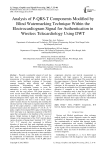
Статья научная
Presently considerable amount of work has been done in tele-monitoring which involves the transmission of bio-signals and medical images in the wireless media. Intelligent exchange of bio-signals amongst hospitals needs efficient and reliable transmission. Watermarking adds “ownership” information in multimedia contents to prove the authenticity, to verify signal integrity, or to achieve control over the copy process. This paper proposes a novel session based blind watermarking method with secret key by embedding binary watermark image into (Electrocardiogram) ECG signal. The ECG signal is a sensitive diagnostic tool that is used to detect various cardio-vascular diseases by measuring and recording the electrical activity of the heart in exquisite detail. The first part of this paper proposes a multi-resolution wavelet transform based system for detection ‘P’,‘Q’,‘R’,‘S’,‘T’ peaks complex from original ECG signal of human being. ‘R-R’ time lapse is an important component of the ECG signal that corresponds to the heartbeat of the concerned person. Abrupt increase in height of the ‘R’ wave or changes in the measurement of the ‘R-R’ interval denote various disorders of human heart. Similarly ‘P-P’, ‘Q-Q’, ‘S-S’, ‘T-T’ intervals also correspond to different disorders of heart and their peak amplitude envisages other cardiac diseases. In this proposed method the ‘P Q R S T’-peaks are marked and stored over the entire signal and the time interval between two consecutive ‘R’-peaks and other peaks interval are measured to detect anomalies in behavior of heart, if any. The peaks are achieved by the composition of Daubechies sub-bands wavelet of original ECG signal. The accuracy of the P, QRS and T components detection and interval measurement is achieved with high accuracy by processing and thresholding the original ECG signal. The second part of the paper proposes a Discrete Wavelet Transformation (DWT) and Spread Spectrum based watermarking technique. In this approach, the generated watermarked signal having an acceptable level of imperceptibility and distortion is compared to the Original ECG signal. Finally, a comparative study is done for the intervals of two consecutive ‘R-R’ peaks, ‘P-R’, ‘Q-T’, ‘QTc’, QRS duration, cardiac output between original P, QRS and T components detected ECG signal and the watermarked P,QRS and T components detected ECG signal.
Бесплатно
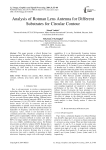
Analysis of Rotman Lens Antenna for Different Substrates for Circular Contour
Статья научная
This paper presents a trifocal Rotman lens design approach. The effect due to change of substrate on the circular contour is observed. The shape of the beam contour is taken as circular. Different substrates can be used for the fabrication of the lens. Three different materials have been used to fabricate the lens antenna .A three beam prototype feeding five element antenna array working in ISM band has been simulated using RLD1.7.Effects on the performance of the antenna is observed.
Бесплатно
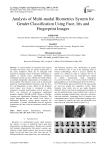
Статья научная
A certain number of researchers have utilized uni-modal bio-metric traits for gender classification. It has many limitations which can be mitigated with inclusion of multiple sources of biometric information to identify or classify user’s information. Intuitively multimodal systems are more reliable and viable solution as multiple independent characteristics of modalities are fused together. The objective of this work is inferring the gender by combining different biometric traits like face, iris, and fingerprints of same subject. In the proposed work, feature level fusion is considered to obtain robustness in gender determination; and an accuracy of 99.8% was achieved on homologous multimodal biometric database SDUMLA-HMT (Group of Machine Learning and Applications, Shandong University). The results demonstrate that the feature level fusion of Multimodal Biometric system greatly improves the performance of gender classification and our approach outperforms the state-of-the-art techniques noticed in the literature.
Бесплатно
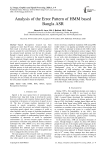
Analysis of the Error Pattern of HMM based Bangla ASR
Статья научная
Speech Recognition research has been ongoing for more than 80 years. Various attempts have been made to develop and improve speech recognition process around the world. Research on ASR by machine has attracted much attention over the last few decades. Bengali is largely spoken all over the world. There are lots of scopes yet to explore in the research regarding offline automatic Bangla speech recognition system. In our work, a moderate size speech corpus and a HMM based speech recognizer have been built to analyze the error pattern. Audio recordings have been collected from different persons in both quiet and noisy area. Live test has been carried out also to check the performance of the model individually. The percentage of the error and the percentage of correction with the created models are presented in this paper along with the results obtained during the live test. Finally, the results are analyzed to get the error pattern needed for future development.
Бесплатно

